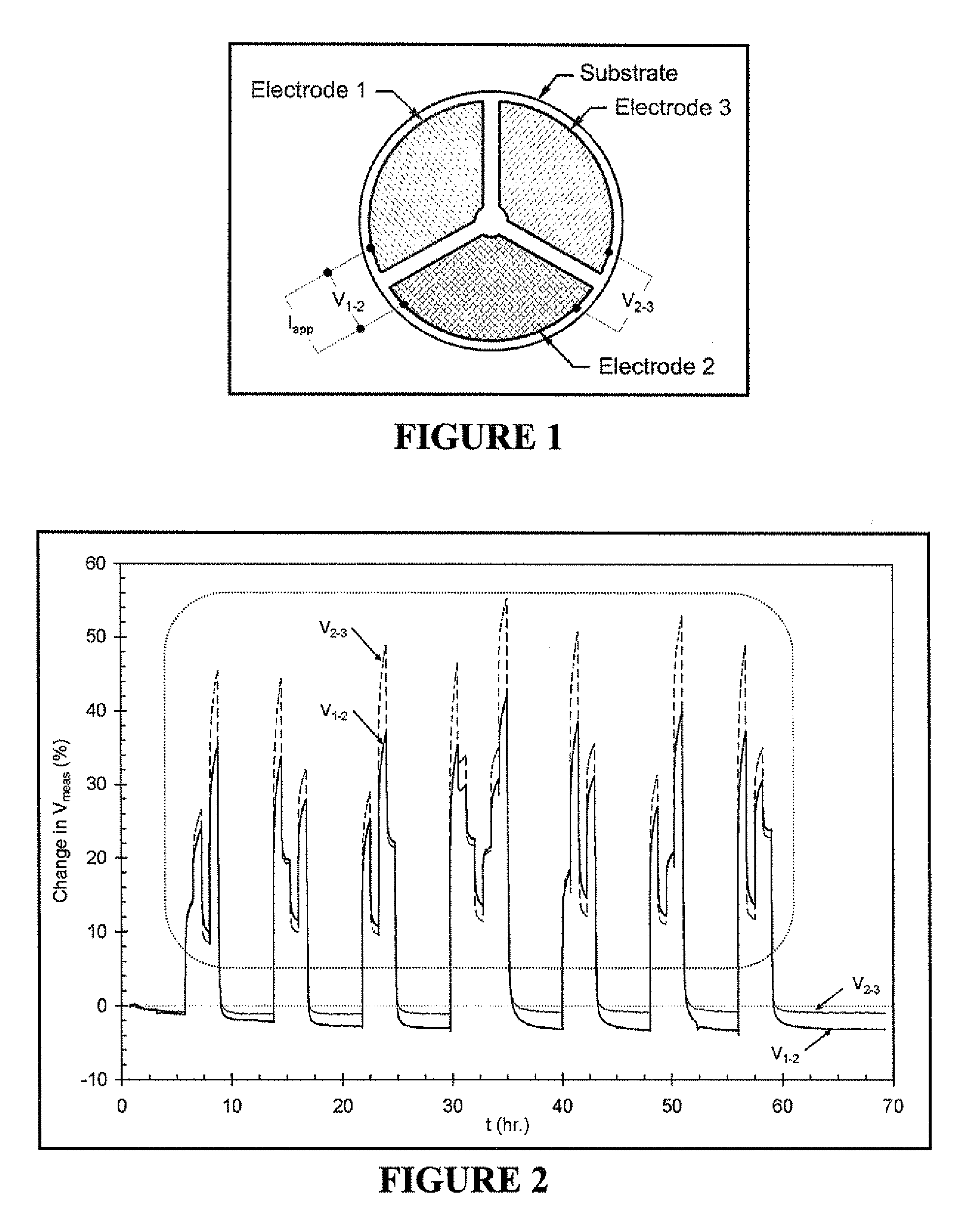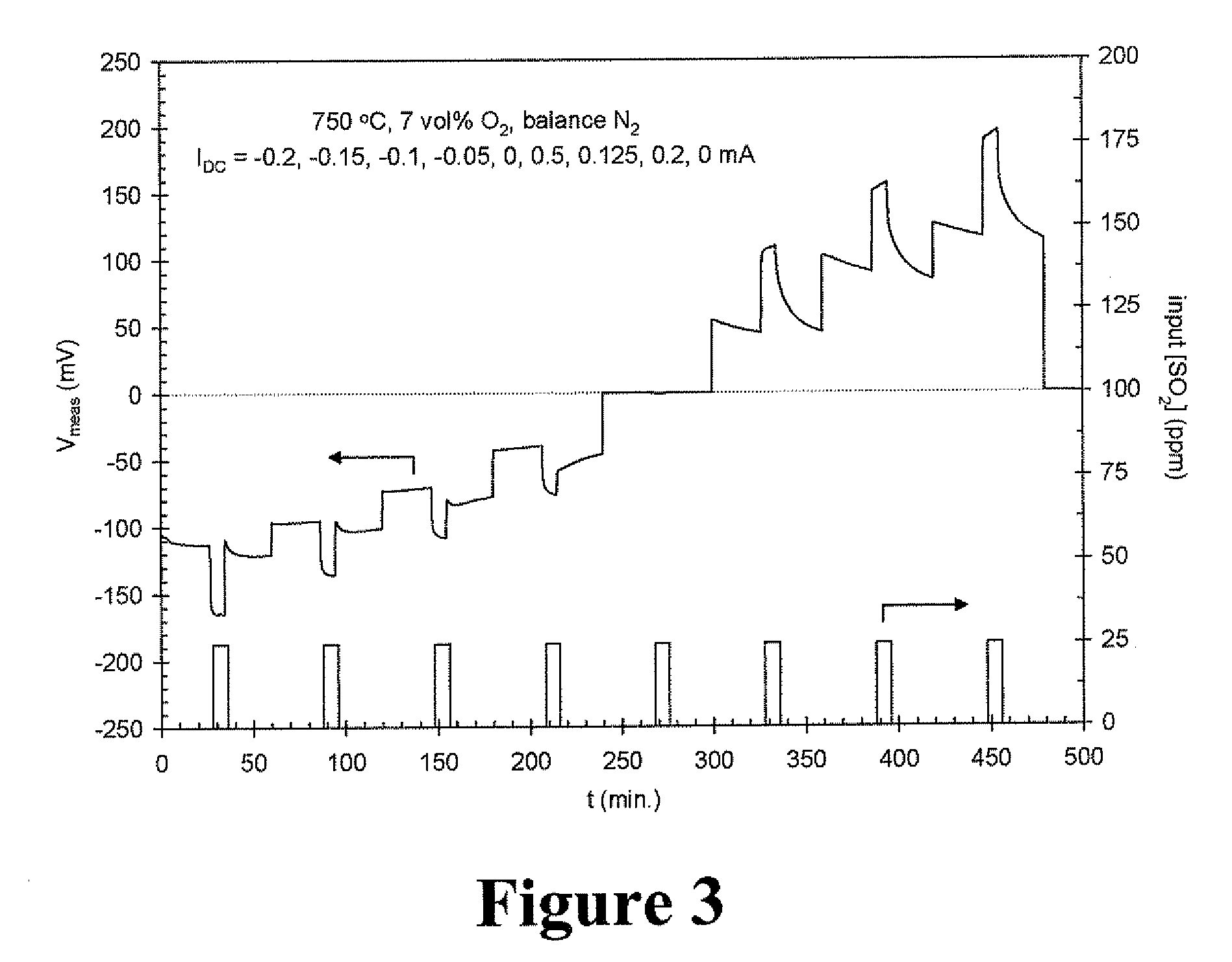Device and method for detecting sulfur dioxide at high temperatures
a high temperature, sulfur dioxide technology, applied in chemical methods analysis, resistance/reactance/impedence, instruments, etc., can solve the problems of increasing the chance that active species can decompose or react with other species, affecting the environment, and affecting the effect of reducing the number of active species
- Summary
- Abstract
- Description
- Claims
- Application Information
AI Technical Summary
Benefits of technology
Problems solved by technology
Method used
Image
Examples
example 1
Operation of a Three-Electrode Device
[0122]A preferred embodiment of the invention is shown in FIG. 1. As shown in FIG. 1, this embodiment includes three electrodes, roughly equal in area, on an oxygen ion-conducting substrate. The oxygen ion-conducting substrate has the composition Zr0.84Y0.08O1.92. The composition of electrode 1 is LaCr0.98O3, the composition of electrode 2 is LaCr0.85Mg0.15O3, and the composition of electrode 3 is Pt. The device shown in FIG. 1 was mounted in a fixture that allowed electrical contact (via Pt mesh) to each of the three electrodes and also allowed gas mixtures to be flown directly onto the electroded side of the device. The fixture and device were placed in a resistively heated tube furnace and heated to a temperature of 900° C. A gas mixing unit was then used to supply a mixture of 7 vol % O2, 1.2 vol % H2O (balance N2) to the device. A Keithley 2400 SourceMeter was then used to drive a DC current of 0.125 mA (Iapp in FIG. 1) from electrode 1 to e...
example 2
Effect of Sign and Magnitude of Applied Direct Current
[0125]A device having one electrode made of La0.6Sr0.4Co0.2Fe0.8O3 (electrode 1), one electrode made of LaCr0.85Mg0.15O3 (electrode 2), and one made of Pt (electrode 3) was constructed and operated in accordance with Example 1, except that the operating temperature was 750° C. and no H2O was intentionally added to the gas mixtures. The 2400 SourceMeter of Example 1 was programmed to apply DC currents of −0.2, −0.15, −0.1, −0.05, 0, 0.5, 0.125, 0.2, and 0 mA for periods of one hour each. The gas mixing unit was programmed to supply 25 ppm pulses of SO2 to the device at each of these current settings. The pulses of SO2 were eight minutes in duration and were applied at each current setting after the applied DC current had been constant for 26 minutes.
[0126]The resultant measurements are shown in FIG. 3, which shows V2-3 (the DC voltage between the LaCr0.85Mg0.15O3 and Pt electrodes) as a function of time. For both negative and posi...
example 3
Dependence of Response Magnitude on Concentration of SO2
[0127]The device of Example 2 was subjected to the following measurement procedure: At a temperature of 750° C. and with an O2 concentration ([O2]) of 7 vol %, −0.18 mA was applied between electrodes 1 and 2. [O2] was then changed to 20 vol %, then to 2.4 vol % and held there while the input concentration of SO2 ([SO2]) was varied between 3 and 17 ppm and then set to 0. V2-3 was monitored throughout this series of gas concentration changes and the resultant data are shown in FIG. 4 wherein it is shown that the changes in V2-3 are a single-valued, monotonically increasing function of [SO2] over the range 3-17 ppm. This function furnishes a mathematical relation between the amount of SO2 in the mixture and the changes in V2-3 and thus the measured change in V2-3 can be used to infer the amount of SO2 in a gas mixture containing an unknown amount of SO2. The foregoing shows that the invention is useful for the quantitative detect...
PUM
| Property | Measurement | Unit |
|---|---|---|
| temperature | aaaaa | aaaaa |
| temperature | aaaaa | aaaaa |
| temperature | aaaaa | aaaaa |
Abstract
Description
Claims
Application Information
 Login to View More
Login to View More - R&D
- Intellectual Property
- Life Sciences
- Materials
- Tech Scout
- Unparalleled Data Quality
- Higher Quality Content
- 60% Fewer Hallucinations
Browse by: Latest US Patents, China's latest patents, Technical Efficacy Thesaurus, Application Domain, Technology Topic, Popular Technical Reports.
© 2025 PatSnap. All rights reserved.Legal|Privacy policy|Modern Slavery Act Transparency Statement|Sitemap|About US| Contact US: help@patsnap.com



